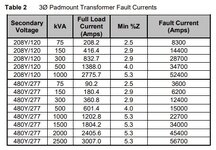CuriousElectron
Electrical
- Jun 24, 2017
- 191
Hi All,
When specifying 1MVA transformer or above, do you usually specify its impedance based on short circuit-study performed to determine what the impedance should be, or do you go with OEM recommended standard value for the size transformer and then specify appropriate kAIC and protective device interrupting ratings of equipment located downstream?
Just curious about what a typical procedure is here.
Thank you,
EE
When specifying 1MVA transformer or above, do you usually specify its impedance based on short circuit-study performed to determine what the impedance should be, or do you go with OEM recommended standard value for the size transformer and then specify appropriate kAIC and protective device interrupting ratings of equipment located downstream?
Just curious about what a typical procedure is here.
Thank you,
EE

